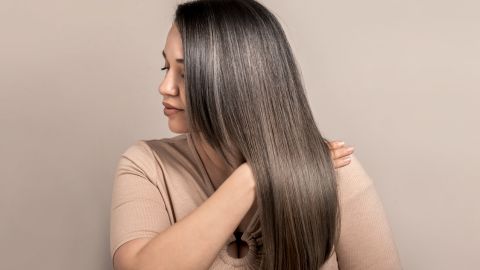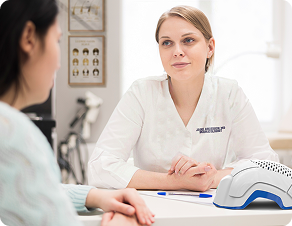Are you wondering whether you have thick or thin hair? Thick hair has a coarse, dense feel and a voluminous appearance. The strands are abundant, and the overall volume is full. On the other hand, thin hair has narrower individual strands and tends to appear finer, sleeker and flatter.
When understanding your hair type, the difference between thick and thin hair goes beyond just how it looks or feels. One key factor is the number of hair fibers on your head. On average, a person with thin hair typically has about 50,000 to 80,000 hair fibers, while someone with thick hair can have anywhere from 100,000 to 150,000 fibers. This significant difference in hair count plays a big role in how your hair appears and behaves.
But fiber count isn't the only way to tell thick and thin hair apart. In this blog, we'll explore various characteristics that can help you identify whether you have thick or thin hair and provide tips on how to care for each type. Understanding your hair type is the first step towards giving it the right kind of attention and care it needs to look and feel its best.
3 Major Differences Between Thick and Thin Hair
The main difference between thick vs thin hair lies in the individual hair strands and their density on the scalp. Three key factors set them apart: diameter, hair density, and hair texture. Now, let's explore them in detail for a better understanding.
1. Diameter of Hair Strands
The diameter of individual hair strands is a primary factor distinguishing thick and thin hair. Thick, coarse hair is characterized by a larger strand diameter, resulting in a fuller, more voluminous appearance. On the other hand, thin hair is characterized by a smaller strand diameter, making it appear more delicate and less voluminous.
2. Hair Density
Hair density is a great way to tell if you have thick or thin hair. Hair density refers to the number of hair strands per square inch on the scalp. Thick hair tends to have a higher density, meaning more hair strands are present. This higher hair density contributes to the overall hair thickness and fullness. With more thick hair strands covering the scalp, thick hair can create a dense and abundant look. Conversely, thin hair has a lower density, with fewer hair strands. The contrast in hair density affects how "full" the hair looks, even if individual strands are similar in thickness.
3. Hair texture
Hair texture plays a significant role in distinguishing between thick and thin hair. Thick hair often has a coarser texture because of the larger diameter of its strands, giving it a stronger, more resilient feel that can better withstand styling and manipulation. Alternatively, thin hair typically has a smoother hair texture due to its finer strands, making it more prone to breakage and damage. As a result, thin hair requires gentler handling and the use of lighter styling products.
Also Read: How to use a hair texture chart to identify your hair type?
How to Identify Thick Hair

If you're trying to determine whether you have thick hair, there are a few simple observations you can make. Thick hair is generally characterized by more textured, fuller strands. Here are some methods to help you identify if your hair is thick:
Examine the Diameter of Each Strand
Thick hair generally has a larger hair shaft diameter compared to fine or thin hair. You can assess the hair thickness by examining individual strands and comparing them to a piece of thread or a pencil.
Feel the Density and Weight
You can tell you have thick hair by feeling its density and weight. Thick hair tends to feel full and heavy in your hand when you run your fingers through it. It may have a substantial amount of hair between your fingers, indicating a high density of strands.
Observe How Much Hair You Lose
One simple way to identify thick hair is by observing how much hair you lose. You likely have thick hair if you don't lose a significant amount of hair during regular brushing or washing. Thick hair tends to have a higher density, resulting in less hair shedding than thinner hair types.
Observing the Volume
You can tell if you have thick hair by looking at the volume. Thick hair has plenty of body and bounce, making ponytails and braids appear fuller and more substantial. It also provides complete coverage of the scalp, unlike thin hair, which may reveal patches of the scalp.
Check How Well Your Hair Holds a Curl or Style
Thick hair holds curls and styles better than thin hair. Once curled or styled, thick hair tends to maintain its shape and volume throughout the day due to the greater weight and diameter of each strand. On the other hand, thin hair may struggle to hold curls and often falls flat more quickly.
Also Read: Why Are Some of My Hairs Thicker Than Others?
How to Take Care of Thick Hair?
Thick hair can be both a blessing and a challenge. While it offers natural volume and style versatility, it also requires specific care to manage its abundance and maintain its health. Here are some key tips to help you take care of your thick locks:
- Use a moisturizing shampoo and conditioner to hydrate your hair and prevent dryness.
- Incorporate a deep conditioning treatment into your routine at least once a week to nourish and soften your hair.
- Avoid over-washing your thick hair, as it can strip it of natural oils. Aim for 2-3 times a week.
- Limit heat styling tools like blow dryers and straighteners to avoid damage, and always use a heat protectant spray when you do style.
- Thinning out your thick hair with proper technique can reduce hair density and make it easy for styling and taking care of.
How to Identify Thin Hair?

Thin hair can be identified by paying attention to specific characteristics. Here are some simple ways to identify thin hair from thick hair:
Lack of Volume
One easy way to distinguish thin hair from thick hair is by looking at its volume. Thin hair often looks flat and lacks fullness, while thick hair appears fuller and has more body. When you style thin hair, it may seem limp and struggle to hold shape or volume, even with products. On the other hand, thick hair naturally has more lift and can easily create a fuller look. This lack of volume in thin hair is due to fewer hair strands and each strand being finer, which makes it harder to create a sense of thickness or fullness on the head.
Visible Scalp
Thin hair usually reveals the scalp more prominently. If you can easily see your scalp through your hair, with more visible skin than hair, it indicates that you likely have thin hair. This can give your hair a sparser, less dense appearance.
Increased Hair Shedding
You may have thin hair if you notice you are losing more hair than usual, especially during brushing or washing. The fragility of thin hair strands makes them more prone to breakage and shedding, resulting in noticeable hair fall. Thin strands are lighter and less dense, making it easier to lose more hair visibly during brushing, washing, or styling. With thick hair, shedding is less noticeable since each strand is coarser and fuller, so even if some fall out, the overall volume stays balanced.
Smaller Diameter
Thin hair is often characterized by its smaller diameter. By examining individual strands closely, you'll notice they are much narrower compared to those of thick hair. This finer diameter is a clear indicator of thin hair.
How to Take Care of Thin Hair?
Caring for thin hair is different from thick hair because it needs extra attention to maintain volume and avoid breakage. Thin hair can be more delicate, so using lightweight products and gentle techniques is key to keeping it healthy. Follow the below tips to take care of your thin hair:
- Use a lightweight shampoo and conditioner to avoid weighing down your hair and help maintain volume.
- Avoid heavy styling products like gels or creams that can make thin hair look flat and greasy.
- Be gentle when washing and drying. Use lukewarm water, pat hair dry with a microfiber towel, and avoid rubbing vigorously to prevent breakage.
- Minimize heat styling to protect your fragile strands from damage and breakage.
Thick vs. Thin Hair: Side-by-Side Comparison
| Aspect | Thick Hair | Thin Hair |
|
Hair Thickness |
Thick hair has a greater density of hair follicles, resulting in a fuller appearance. |
Thin hair lacks volume and may appear sparse. |
| Texture | Thick hair often has a coarse and heavy texture. | The texture of thin hair is often noticeably smooth and lightweight. |
| Volume | Natural full and bouncy | Lacks natural volume |
| Styling | Holds styles well | It can be easily weighed down |
| Heat Styling | Thick hair can tolerate higher heat settings compared to thin hair. | Whereas, thin hair is more susceptible to heat damage. |
Why It's Important to Know If You Have Thick or Thin Hair?
It's very important to know whether you have thick or thin hair. Knowing your hair type helps you find the best products, haircuts, and styles for your specific needs. For instance, if you have thin hair, using volumizing shampoos and lightweight conditioners can help add body and fullness. On the other hand, if you have thick hair, look for products that provide moisture and control and can help manage its density and texture effectively.
Thick and thin hair also require different kinds of haircuts and styles. The right haircut can also make a big difference - certain styles maximize volume for thin hair or remove bulk for thick hair. For thin hair, certain cuts and layering techniques can create the illusion of more volume and thickness. For thick hair, choosing hairstyles that embrace its natural texture and provide structure can help prevent it from appearing unruly or weighed down. Ultimately, identifying whether you have thick or thin hair allows you to make informed decisions about your hair care routine, ensuring that you achieve the best results for your unique hair type.
Conclusion
Thick vs. thin hair can be distinguished by looking at factors like strand diameter, hair density, hair texture, and overall volume. Thick hair has wider, more textured strands, greater hair density, and is bouncy. However, thin hair has narrower, smoother strands, less density, and a flatter, more limp appearance. Examining the width and feel of your hair strands, amount of shedding, scalp visibility, and how well your hair holds styles can help you identify if your hair is thick or thin. Moreover, knowing your hair type allows you to choose products and styles best suited for you.
LPT for Treating Hair Thinning and Loss
LPT or Laser Phototherapy, is a non-invasive treatment option for hair thinning and loss. It involves using laser devices to stimulate hair growth and improve the overall health of the scalp. One popular LPT device is the Theradome hair helmet, designed for home use. Theradome is a helmet-like device that emits red laser light to penetrate the scalp and stimulate the hair follicles.
There are two kinds of Theradome Helmet: Theradome PRO LH80 and EVO LH40, which are designed to be user-friendly and used conveniently at home. Both models deliver painless and gentle treatment sessions that increase blood flow to the hair follicles, leading to thicker, fuller hair and reduced hair loss.






















